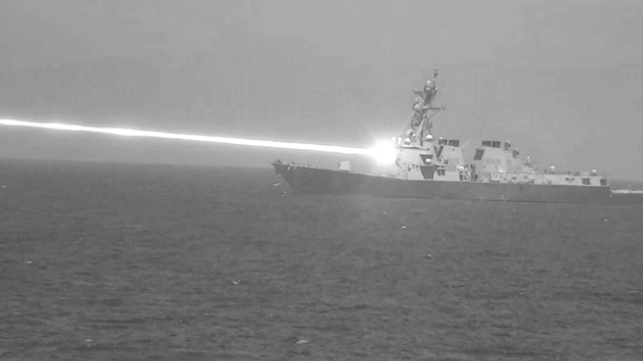USS Preble Tests High-Powered Laser Weapon

The Pentagon's Director of Operational Testing & Evaluation has released a rare image of the U.S. Navy's HELIOS anti-drone laser in action. One prototype unit was mounted aboard the destroyer USS Preble in 2022, and it was tested against an aerial target at some point last fiscal year, DOT&E said.
The test was designed to "verify and validate the functionality, performance, and capability of [HELIOS] against an unmanned aerial vehicle target," the agency said, without providing further information.
HELIOS is a 60-kilowatt-class solid state laser, mounted in a gimbaled pedestal along with high-resolution cameras and sensors. It is integrated directly with the Aegis fire control system, the detection, targeting and engagement software platform used by the U.S. Navy's surface combatants.
The HELIOS laser is designed to destroy small aerial and waterborne targets at low cost, with a bottomless magazine. Both factors are appealing for use against low-cost threats like bomb boats and small UAVs: in theory, a laser-equipped warship could defend itself against these smaller munitions while conserving its expensive and limited air defense missiles for bigger problems. The service's leaders have pressed for progress on laser weapons, especially after the last year of high-intensity engagement with Houthi drones in the Red Sea.
However, defense R&D labs have had a hard time building field-ready laser weapons: 11 years after the Navy installed its first deployed laser aboard USS Ponce and announced operational success, the technology has yet to take off fleetwide.
The technical challenges of fielding a viable laser weapon are substantial. The laser needs enormous amounts of power from the ship's generators; it needs to track each aerial target for up to several seconds in order to burn through it; at longer ranges, the beam must be calibrated to adjust for atmospheric variations; and the device itself has to be cooled to dissipate heat in operation. In naval service, it also has to be robust enough to withstand vibration, salt spray and ship motion.
Shipboard installations have certain advantages over airborne and ground-mobile laser payloads. Warships have access to unlimited seawater for cooling, and compared to trucks or aircraft, they have a relative abundance of carrying capacity and electrical power. However, like efforts in the Air Force and Army, the Navy's laser weapons programs have yet to (publicly) evolve past demonstration-scale installations, despite repeated announcements of success.
The Royal Navy is on track to deploy a combined beam fiber laser in the 50-kilowatt class - about the same power level as HELIOS - and will be rolling it out to the fleet from 2027. Despite the far smaller size of its R&D budget, the UK claims to have achieved an operational model suitable for shipboard counter-drone use.
“We recognize this cutting-edge UK laser weapons technology as highly relevant and the need to accelerate it into service on board our ships at the earliest opportunity," said Captain Matt Ryder, Head of Above Water Battlespace in the Royal Navy’s Develop Directorate, in a statement last year.
